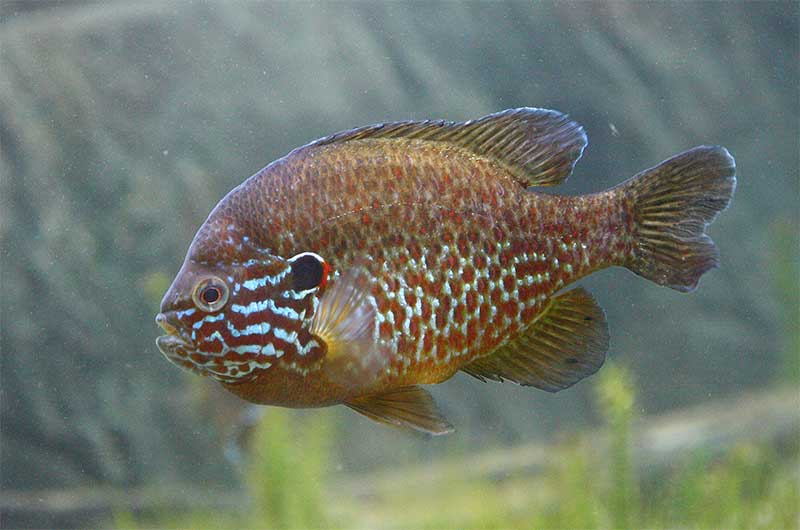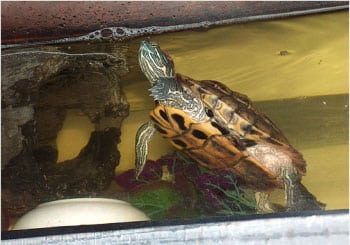~ by Dr. Sarah D. Oktay, Director, University of Massachusetts Nantucket Field Station ~
We had a little bit of drama in the UMass Boston Nantucket Field Station lab on Friday. Trawalney, our 15-20 year old red eared slider turtle (named by one of our junior rangers) decided the beautiful six inch long pumpkinseed fish that has been her companion for 4-5 years needed to die. Sometimes roommates don’t get along and sometimes they get hungry. I have always wondered why that hadn’t happened sooner. Last summer when our junior rangers caught a similar sized pumpkinseed and placed it into the tank with Trawalney she had immediately attacked and killed it! I don’t know how much fish think but that had to be at least disquieting to the larger pumpkinseed. Most of the time, the pumpkinseed would hang out beyond Trawalney’s reach in a fake log we have in the tank just for that purpose, but as it got bigger, the fish and Trawlney seemed to have a détente going that was I am sure highly dependent on the amount of food they received. An even smaller pumpkinseed who has also been a tank resident for years, recognizing a natural born killer, always was very careful to hide amongst the rocks. “Big Fish” (we are not the most creative namers at the Field Station) had a tattered tail due to some spirited nipping by Trawalney about 2 months ago, and this time there was no way I could easily save it. Trawalney just decided she was bored and hungry and instead of eating a large bag of Doritos, decided to go after Big Fish. In seconds, Big Fish had one less pectoral fin and a big gouge in its back and was having difficulty swimming and avoiding Trawalney who was doing her best Great White impression. I agonized as to the kindest thing to do for the fish, and decided to move it to the pond where an osprey or snapping turtle could finish it off quickly and humanely.

Winding back about 6 years, a friend brought Trawalney to the Nantucket Field Station for us to use as an educational tool for visitors after he decided he could no longer care for it. It was hard for him to give up his pet and an unselfish act and as you’ll see it was also the right thing to do as opposed to releasing it into the wild. It’s a pretty hefty little turtle about 10 inches long with expressive eyes and a fair amount of attitude. Trawalney is definitely a girl (shorter tail, much smaller claws, wide head, more at https://www.youtube.com/watch?v=O7FaNvJR4rE ) who likes to be fed by hand (and enjoys nipping pretty hard) and loves paddling about and occasionally hauling out to warm up under her heat lamps.
Unfortunately Trawalney and her friends are a non-native species in Massachusetts and when released can quickly force out other less competitive and aggressive aquatic turtles. Red eared sliders are sold in pet stores to people who want a low maintenance pet. Unfortunately, this species has more heating, space and lighting requirements than one would think. It’s not necessarily the Jessica Simpson or Kanye West of pets, but neither are they pet rocks, and when people find out there is a lot involved both in time and cost, they tend to start rethinking their investment. That is when a bad decision starts impacting our local native turtle species.

We just learned about snapping turtles a week or two ago. You may recall that there are two major groups of turtles: sea turtles, which grow to large sizes and live in the oceans in the temperate and tropical regions of the earth, and fresh-water turtles. The term “turtle” is basically a generic name for the group of reptiles which includes tortoises and terrapins whose body is shielded by a special bony shell developed from their ribs. All extant, or living, turtles are members of the order Testudines, which includes both living and extinct varieties of turtle. The earliest known members of this group date from 157 million years ago, making turtles one of the oldest reptile groups and a more ancient group than snakes or crocodilians. Of the 327 known species alive today, some are highly endangered and the red eared sliders superior survival skills have pushed many of its cousins into an endangered status. We have three different species of turtles on Nantucket who all love to be near freshwater, the spotted turtle (Clemmys guttata), the painted turtle (Chrysemys picta), and the common snapping turtle (Chelydra serpentina).
Fresh-water turtles who spend the majority of their time on the land are generally called tortoises. In the United Kingdom, aquatic fresh-water turtles are known as terrapins. Fresh-water turtles are generally much smaller, ranging in size from a few centimeters to a few feet long. All turtles have a protective shell around their bodies. The top part of their case is called the carapace, the underside is the plastron, and the two are connected by the bridge. Even though they spend large amounts of their lives underwater, aquatic turtles are air-breathing reptiles, and must surface at regular intervals to refill their lungs with fresh air. They also spend part of their lives on dry land. Many aquatic turtles like Trawalney love to bask to warm up. They are ectotherms, or “cold blooded”, their temperature reflects the temperature around them and they are dependent on external sources of heat.
Red-eared sliders are natives of the southern United States, but they have become common in various areas of the world due to the pet trade and it has started to become a problem to us here in the Northeast. As you’ll soon see, we are not alone in addressing this issue as this turtle’s superior survivability, toughness, and aggressive nature allow it to outcompete the native species in areas in the U.S. for habitat and resources. The Red-eared Slider’s indigenous range broadly covers the midwestern states and extends as far east as West Virginia with a disjunct (relict) population in southern Ohio, as far west as eastern New Mexico, and as far south as south of the Rio Grande River into northeastern Mexico (http://nas.er.usgs.gov/queries/factsheet.aspx?SpeciesID=1261)
It has been found in other regions, presumably because people released their pet turtles into those areas. It spends most of its time in or around water. Although it can be found in lakes and rivers, the red-eared slider prefers marshes, ponds, and slow-moving waters that supply food and basking areas. In northern areas it will hibernate (well, technically brumate, i.e., becoming less active but occasionally rising for food or water), which means interlopers on Nantucket will burrow in the mud or somewhere else warm and stay put during most of the winter. Although they prefer quiet waters, red-eared sliders are highly adaptable and can tolerate anything from brackish waters, to manmade canals, and city park ponds. Small turtles usually limit their activity to areas of heavy floating vegetation. It is thought that the terrapins do not feed or grow beyond temperature range of 10°C to 37°C (http://www.issg.org/database/species/ecology.asp?si=71 ). Hatchlings are approximately 1 inch in diameter. The red-eared slider can grow up to 12 inches in length. Red-eared sliders are omnivores and eat a variety of animal and plant materials in the wild including, but not limited to fish, crayfish, carrion, tadpoles, snails, crickets, wax worms, aquatic insects and numerous aquatic plant species.
Red-eared Sliders kept as pets generally reach sexual maturity between 2-4 years of age. In the wild, females may not mature until 5-7 years of age. Females are generally larger than males, though males have longer tails and very long front claws. The skin of a red-eared slider is green with bright yellow stripes. A patch of red behind each eye gives the red-eared slider its common name, although some sliders may be missing this color. Some turtles may also have a small patch of red on top of their heads. The Red-eared Slider has webbed feet and strong claws. The shell of hatchlings is green with a fine pattern of yellow-green to dark green markings. As the turtles mature, the carapace may become yellow or olive green, with the fine pattern changing into dark lines or patches on each scute. Portions of the shell may be white, yellow, or even red. As the turtle ages, the lines and patches may slowly disappear until the shell is a uniform dark olive green or greenish-brown. Some male turtles will become “melanistic” which means will develop a uniformly dark gray or black color as they age. The red-eared slider can live up to 40 years with some individuals reaching 50 or 60 years of age.
Students at the University of Toledo in Dr. Daryl Moorhead’s lab in the Environmental Sciences department have been evaluating the danger to local native turtle species that is posed by the cute red eared gate crasher (http://utnews.utoledo.edu/publish/Research_12/Pet_Store_Turtle_Take_Over_350.shtml). They found that the turtles expand into their range quickly when released and that their aggressive nature and toughness give the turtles a genetic advantage over the smaller cousins. The truth is that many of this country’s non-native invasive wildlife species were brought to the state through the pet industry. There are invasive parrots and African clawed frogs in Los Angeles County, snakehead fish in several states, a plethora of invasive fish and reptiles in Florida, and so on. When possible it is ideal to have laws in place to limit bringing in species that are simply too easy to release. In the United States, it is illegal for pet stores to sell a red-eared slider that has a carapace (shell) less than 4 inches in diameter. The US is also a major exporter of these creatures. According to the Global Invasive Species Database (found at http://www.issg.org/database/species/ecology.asp?si=71): “The red-eared slider (Trachemys scripta elegans) has been the most popular turtle in the pet trade with more than 52 million individuals exported from the United States to foreign markets between 1989 and 1997. Despite the vast worldwide occurrence of the sliders little is known of their impact on indigenous ecosystems, clearly research and education on the dangers of releasing pet turtles into the wild are needed. Their omnivorous diet and ability to adapt to various habitats, gives them great potential for impacting indigenous habitats.”
On top of their aggression, they also can transmit salmonella to people causing them to develop salmonellosis. Since 1975, however, selling baby turtles that are less than 4 inches long has been illegal in the U.S., because some reptiles—red-eared sliders included—can harbor salmonella on their skin (http://www.newsweek.com/illegal-animal-traders-have-turned-baby-red-eared-sliders-health-and-337903). In case you are in doubt, if you have a pet turtle or a pet of any aquatic nature from koi to alligator, once you have decided you no longer can care for it, it is best to escort it to the river Styx.
This web site: http://redearslider.com/ offers some basic information for those of you who have adopted this pet. Portions of this article were originally published in 2010 in Yesterday’s island and can be found at http://yesterdaysisland.com/2010/science/21.php


